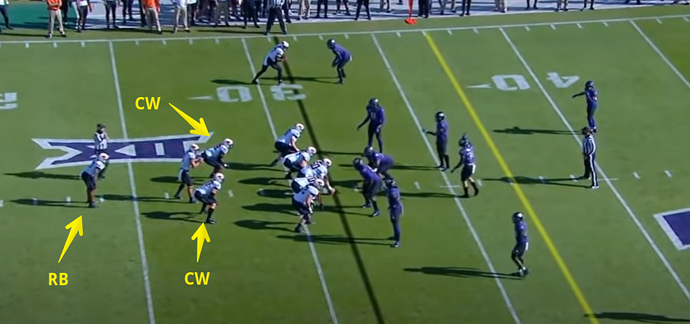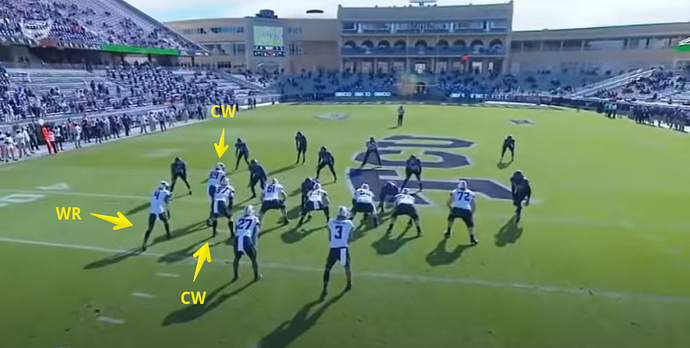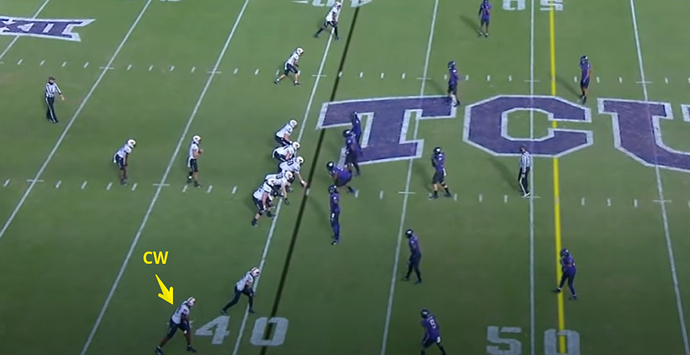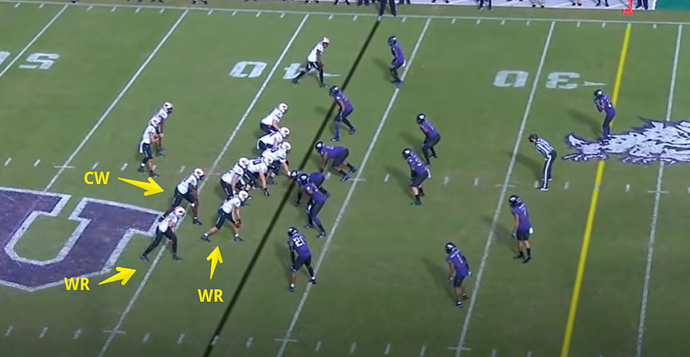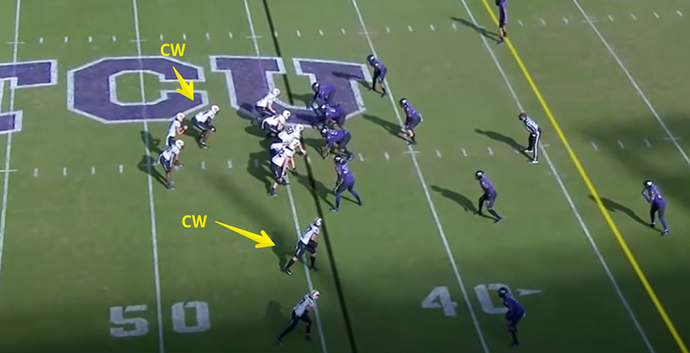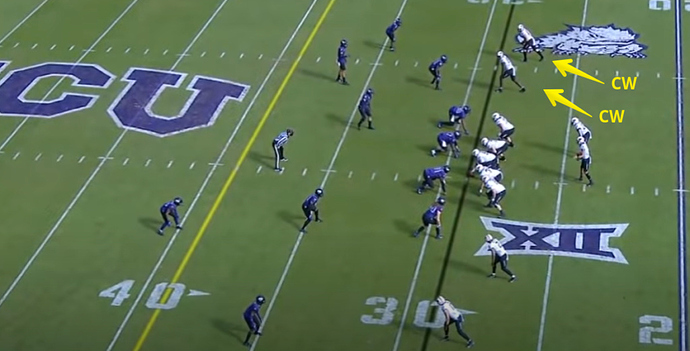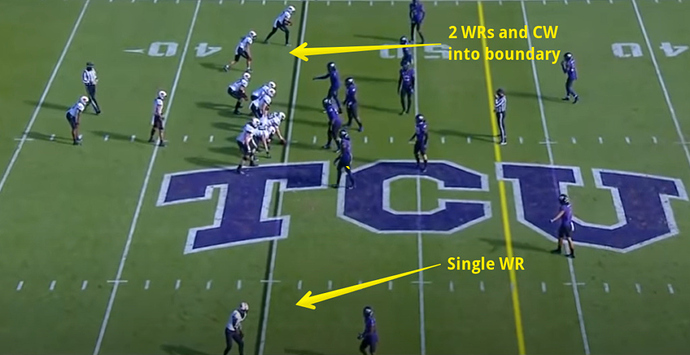Great film study sesh here from @dustinragusa24 for PFB+ subscribers. This is Part 1 of a three-part series. Enjoy!
Oklahoma State suffered its third loss of the season this past Saturday, falling 29-22 to the TCU Horned Frogs. The Cowboy offense never really found a rhythm and wasn't able to capitalize on the five forced turnovers by the OSU defense, including one fumble returned for a touchdown.
JUCO transfer running Dezmon Jackson back didn't replicate his stellar performance from the Texas Tech game, but he was able to pick up 118 yards on 29 carries (4.1 yards per carry) and score one touchdown. Through the air, Cowboy quarterback Spencer Sanders completed only 47% of his passes (16 for 34) and finished with 270 yards, one touchdown and one interception. The OSU special teams unit also had some struggles, as kicker Brady Pohl missed two field goals and an extra point on the day.
It wasn't a great day for the Poke offense and in this week's three-part film break down I'll take a look at offensive coordinator Kasey Dunn's game plan and what worked and didn't work for the Cowboys.
Let's start with by taking an overall look at the scheme.
Overall Scheme
The Cowboy offense opened up this game how they finished the Texas Tech game, going heavy on the 12 personnel (1 running back and 2 Cowboy Backs/Tight Ends) groupings. On their first two drives, the Pokes went to 12 personnel 71% of the time, resulting in 22 yards gained and two punts, while mixing in the formations below:
Diamond
Cowboy Backs as Inside Receivers
Cowboy Back Bunch Formation
The Pokes then flipped the script on the third drive, going 11 personnel (1 running back and 1 Cowboy Back/Tight End) 71% of the time and picked up 57 yards and a touchdown.
After those first three drives, here’s how the personnel groupings shook out for the remainder of the game:
- 10 personnel (1 running back and no Cowboy Back/Tight End) – 8%
- 11 personnel – 55%
- 12 personnel – 34%
- 13 personnel (1 running back and 3 Cowboy Backs/Tight Ends) – 3%
As we’ve seen with the Dunn led offense this season, it has been a heavy dose of 11 and 12 personnel, leading to a majority of the snaps featuring at least one Cowboy Back. And, on Saturday it seemed like Dunn was trying to utilize these Cowboy Backs to create some confusion for Gary Patterson’s TCU defense. For example, the Pokes showed several different formations with the Cowboy Back split wide, similar to the one above and several more examples you’ll see below.
Here we see 11 personnel with the Cowboy Back lined up as an outside receiver, which they showed both in a 2×2 set, or two receivers on each side of the line of scrimmage, like the one below and out of Trips, or three receivers to one side. Also, wanted to note that before the snap the Cowboy Back moved into the backfield.
This can cause some confusion for the defense as typically a cornerback will be covering the outside receiver in most situations, but with a big body like Jelani Woods split out wide in the photo above, the defense may have to put a larger safety or linebacker on this player.
Dunn also went back to the tight bunch formation shown above, but instead of using two Cowboy Backs, he used one Cowboy Back and two receivers.
In addition, we saw a lot of 12 personnel looks with one of the Cowboy backs split as the inside receiver, as you see here.
OSU even went with both Cowboy Backs split to the same side of the formation, shown below, something we haven’t seen much of this season.
Dunn was also moving the Cowboy Backs around a lot with pre-snap motion. Spencer Sanders would perform a hard count to try and get the defense to tip their hand in terms of blitz package or coverage, and then move the Cowboy Back accordingly. See the clip below.
Something else the OSU offense seemed to do pretty frequently on Saturday was set the strength of the formation, specifically the passing strength, to the boundary. As I’ve discussed in some previous posts from this season, setting the strength to the boundary can cause an alignment issue for the defense. Especially if the offense is playing with tempo, the defenses prefer to set the strength to the field, so when the offense goes heavy to the boundary, they can catch the defense off guard.
In Patterson’s defensive scheme, as Sam Bradshaw of SicEm365.com explains, the play calls are divided into three groups.
The Free Safety, Corner, Strong Safety, and one Linebacker operating on one call made by the Free Safety. The Weak Safety, remaining Linebacker, and other Corner operate on the Weak Safety’s call. The Linebackers and Line operate on a front call… The safeties line up based on the passing strength with the weak safety away from the strength and the strong safety is towards it.
[SicEm365]
The video below explains this in more detail.
By going heavy into the boundary, like the formation below, Dunn looked to be trying to create a numbers advantages to the field, or wide side, as well as isolate the field side receiver in one-on-one coverage (Tylan Wallace in the following image).
Overall, I didn’t really love the game plan in this one. Although we saw the Cowboy Backs being moved around a lot, we didn’t see as much wide receiver motion as I would’ve expected after the success OSU found last year against this Horned Frog defense. A season ago OSU went heavy on wide receiver motion and used it to catch the TCU defense guessing. This opened things up in both the passing game and the running game, as you’ll see below.
In terms of play calling, the run/pass split was almost 50/50, as the Pokes threw the ball 36 times and had 40 rushing attempts. However, it just seemed like the play calling lacked flow at times and the Cowboys were really having trouble stringing successful plays together. In addition, aside from a few wrinkles, I feel like we didn’t see a lot of creativity formation-wise and the TCU defense looked well prepared to handle pretty much anything the Pokes threw at them. Patterson’s defenses are known to attack tendencies an offense shows on film, and if you don’t mix things up every now and then, it’s hard to get them out of position.
In the next post I’ll dive in a little deeper into the OSU rushing attack against TCU.
